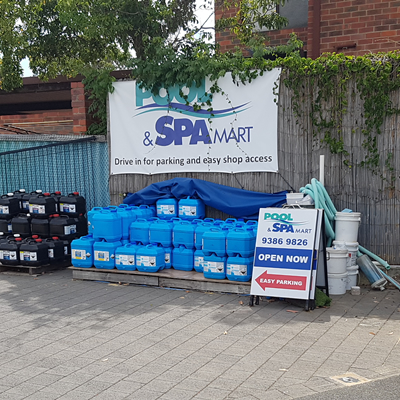FAQs
Pool & Spa Mart provide free sample bottles in store. If you don’t have one yet then be sure to collect the sample in a plastic or glass bottle that has only had water in it. If you collect the water in a soft drink bottle, even if rinsed, it will affect the acidity of the sample. Take a sample when the pool pump is on and has been running for at least an hour.
Don’t collect the sample from the surface of the water- instead if you can get it about an arm’s length underneath that would be better. Also don’t collect a sample too close to the return jets. Take note of how the pool looks- can you see any algae present and does the water look clear? If it’s your first time visiting us it might be a good idea to take a photo of your equipment and estimate the length and width of your pool before coming in. That way we can add these details to our computer to give personalized results each time you come in for a test in the future
- Total Dissolved Solids including Salt
- Chlorine level
- pH
- Stabiliser
- Total alkalinity
- Calcium hardness
- Phosphates
The recommended salt level for your pool will depend on the chlorinator you have as different models require different “ideal salt” levels. You should never just add salt without first having your water tested, even if the chlorinator displays a “low salt” error. First bring your water in for testing to be sure because if you add too much salt it can damage your chlorinator and can only be removed by removing water from your pool.
Chlorine sanitises your pool, killing harmful bacteria to make your pool safe to swim in. It is important to maintain a safe level of sanitation throughout the year.
The pH measures the acidity or alkalinity levels of the pool water. If the pH is not within range, it may cause discomfort to swimmers including skin and eye irritations, scaling, cloudy water and will affect the efficiency of chlorine.
Stabiliser acts like a sunscreen for your pool, preventing the loss of chlorine via direct sunlight.
The Total Alkalinity is the measurement of the alkaline materials in the pool. When the correct level it prevents the pH from changing rapidly, also known as pH bounce. When the total alkalinity is too low the water will be corrosive to the pool equipment and surfaces whereas when it is too high it will be scale forming.
Calcium is required to protect the surface of your pool, especially in concrete pools. If the level is too high, you may notice a discolouration of the pool surface, scale build up or cloudy water. If too low, the pool water will be corrosive, affecting the surface of the pool as well as any metal fittings on your equipment.
Phosphates may enter your pool in several ways such as fertilizer run off from your garden bed, pollen blow into the pool or organic debris such as leaves decaying in the pool. A pool with phosphates may have a dull appearance to the water. Phosphates increase chlorine demand as the chlorine is less effective with phophates present
There isn’t a test we do for algae. Neither is there a test for cloudy water. A sample taken from a green cloudy pool can often look quite clear when you look at a small sample. That’s why we’ll ask you for some more information on the visual appearance of the pool when you come for a test. Some of the questions we might ask are is it cloudy? Can you see anything growing on the sides and what colour is it? Did you try to brush off and would it brush off easily? Can you see the bottom of the pool? Are there any stains on the surface?
If you bring a bore water sample in for testing we can test it for the levels as listed above but we won’t be able to tell you if there are other contaminants in the bore water. Also, it should be noted that the water quality from the bore (and scheme water also) does vary in quality over the course of the year due to rainfall and other factors
There are a few main reasons algae will grow.
- Insufficient filtration and circulation. You need to ensure you run your pool for the recommended hours each day, depending on the season. Be sure to keep on top of routine day to day maintenance such as topping up the water before it gets low as it won’t be able to circulate if it doesn’t easily clear the skimmer box entry. Empty baskets regularly or the pool pump will struggle to circulate the water through the system. Algae likes to cling to the pool walls- brush your pool walls regularly. Make sure you clean/backwash your filter as required also. If the media or cartridge within your filter is old it may unable to filter efficiently.
- Insufficient sanitizer levels. If the chlorine levels are very low then it’s an ideal situation for algae to grow. Even if there is no chlorine in the pool for only a day or two, it can be long enough for algae to start. The pH is also important as the chlorine is less effective when the pH is not within the recommended range.
- Organic materials and phosphates. Just like your garden loves phosphates, nitrates, compost and sunlight to grow, so too does algae. By allowing leaves to sit in the pool too long and decompose you’re giving the algae an ideal environment to grow in. The sunshine will only add to the perfect conditions for algae. When phosphates are present you are far more likely for your pool to develop algae. Visit your local Pool & Spa Mart store to have your water tested and treated.
There are a number of ways to increase the energy efficiency of your pool. Not only does this help the environment but it will also reduce your power bills. The power that your pool uses can be reduced in a number of ways
Pump
Your pool pump is the heart of the pool as it pumps the water through the entire pool and filtration system. Your pump will use more or less energy depending on the work you give it to do and the other equipment on the filtration system. Depending on the situation of your pool and the existing equipment, a variable speed pump could be a great investment to help reduce your power bills. Pool & Spa Mart recommend Hayward’s TriStar VS pump which is the only pump that gets a 10 star energy rating. The savings you could enjoy from switching to a Hayward TriStar VS pump can be seen here
Chlorinator
While salt is cheap, the process by which your chlorinator uses the salt water to create chlorine does use energy. The power required to run a salt system is much higher than that required to run a liquid chlorine feeder system. Salt chlorinators work for the entire time that the pool is on while a Chemigem only activates the feed as required. When you weigh it up you may find that the cost difference between a salt pool and chlorine pool isn’t as big as you first thought. Another advantage of the Chemigem D10P system is that it works very well in conjunction with a variable speed pump
Filter and baskets
While filters and skimmer boxes don’t use power whilst operating, proper maintenance of these components will reduce the power drawn by your pool pump. Sand filters should be backwashed monthly and cartridge filters cleaned regularly to reduce the amount of hard work your pump needs to do to circulate the water through the filtration system. Likewise, baskets should be cleared of debris regularly or the pump has to work harder to pull the water through. Make sure you attend to routine maintenance, or ask about our regular maintenance if you’d prefer our technicians take care of it for you
Cleaner
Do you have a suction cleaner? They reduce the flow of water to the pump and make it draw more power. Consider investing in a robotic cleaner which will leave your skimmer box unrestricted and save power- they even help do the work of your filter as they filter the water in the pool as they clean!
Running times
The obvious answer people might think of is to reduce the run-time of the pool but this can actually have the opposite effect as the pool will develop algae if the water doesn’t have enough circulation. Another thing that you might consider is running your pool at night time to take advantage of reduced off-peak energy tariffs but, again, this is a bad idea. You need the water to be circulating, and the water to be sanitized, while the sun is on it. Otherwise, after a few hours in the heat your stagnant pool water will have no chlorine left in it and will be unsafe to swim in. Do you have kids arriving home from school at about 4pm ready for an afternoon dip? Make sure the pool timers are set to come on a couple of hours prior to ensure safe, sanitized water. The recommended hours during summer are 8am-12 and 2pm-6pm. A common mistake is to just forget about the pool once the swimming season is over but winterizing your pool is very important. We have clients who leave their timers on for 8 hours a days and their chlorinators turned up to the highest output throughout autumn, winter and spring unnecessarily because they forget about the pool. This will reduce the life of your equipment and is a waste of power
Pool chemicals should be handled carefully and should not be mixed with each other. Be sure to take care when dosing your pool or spa with chemicals. Read the packets and ask for advice in store. When storing chemicals you should seal them up properly so they don’t get wet. Liquid products should not be stored above dry products in case of a leak
ALWAYS REMEMBER
- Add chemicals to water NOT water to chemicals
- When dosing more than one chemical wait at least one hour between additions unless advised or instructed otherwise by your pool professional
- Run the pool or spa pump when dosing to circulate water.
- Keep chemicals out of reach of children and sealed properly to avoid spillage and harm.
- Never mix chemicals, it may cause a harmful chemical reaction.
- Follow packaging instructions unless advised otherwise by Pool & Spa Mart.
- Follow your water test sample report and measure chemicals needed accordingly.
Daisy solar pool covers can reduce evaporation by up to 97% so if you’re serious about saving water, ask your local Pool & Spa Mart for a free measure and quote. If that’s not a possibility for you, for example if you’re renting, there are also liquid blanket products that help reduce evaporation (to a lesser extent than a physical pool blanket) by increasing the surface tension of the water
Find your local Pool & Spa Mart
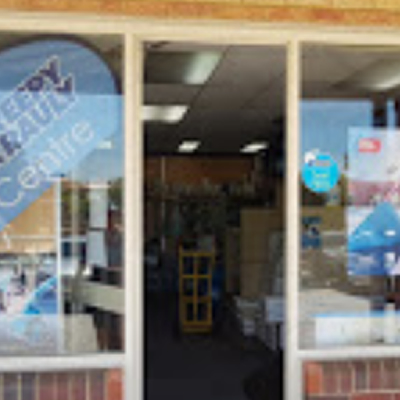
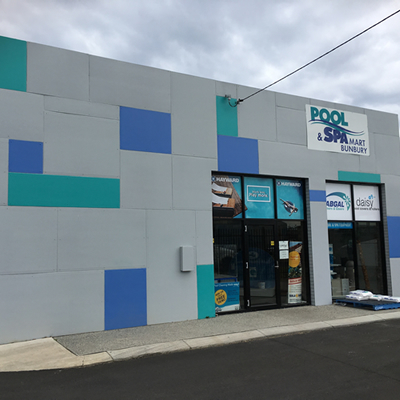
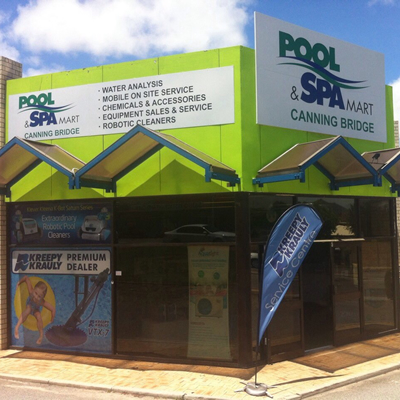
Canning Bridge
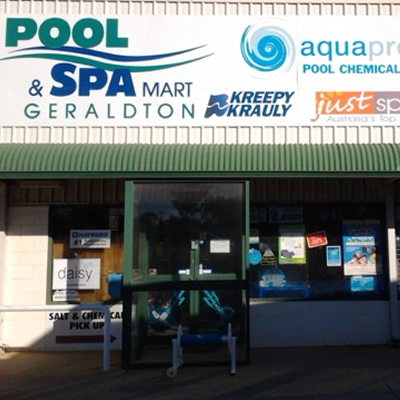
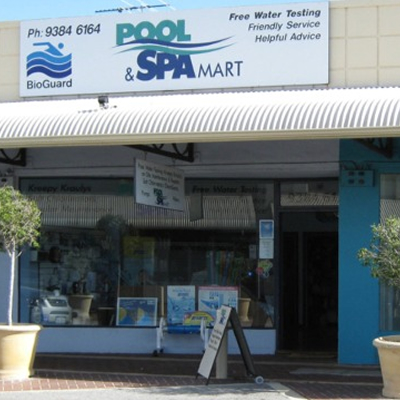
Mosman Park
